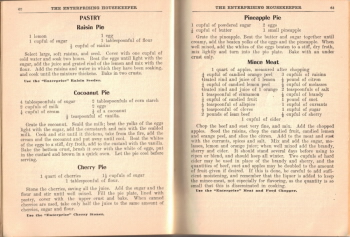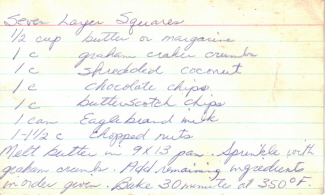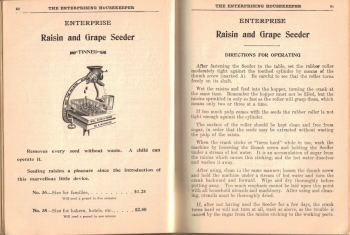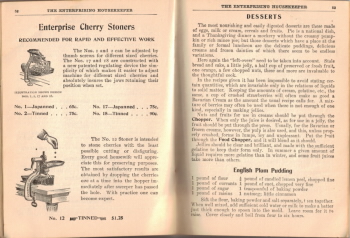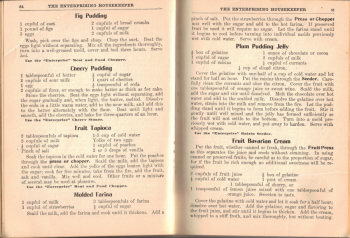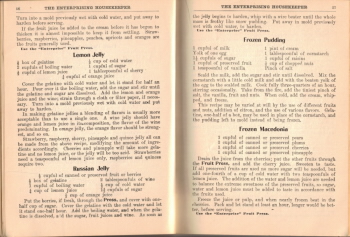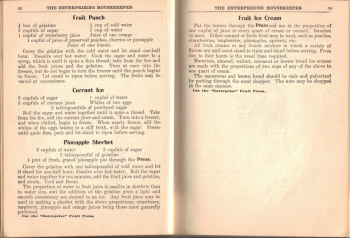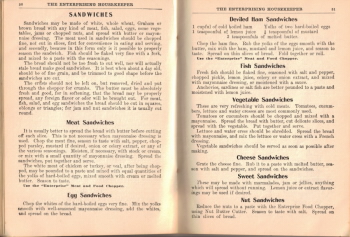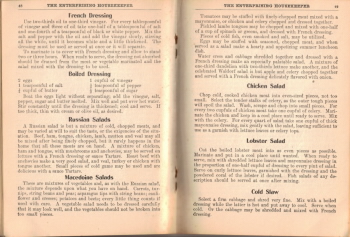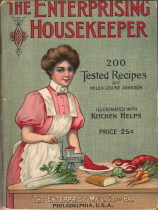 Here are pages 62 and 63 from the vintage booklet The Enterprising Housekeeper from the sixth edition (1906).
Here are pages 62 and 63 from the vintage booklet The Enterprising Housekeeper from the sixth edition (1906).
Pastry
Raisin Pie
1 lemon
1 cupful of sugar
1 egg
1 tablespoonful of flour
1/2 cupful of raisins
Select large, soft raisins, and seed. Cover with one cupful of cold water and soak two hours. Beat the eggs until light with the sugar, add the juice and grated rind of the lemon and mix with the flour. Add the raisins and water in which they have been soaking, and cook until the mixture thickens. Bake in two crusts.
Cocoanut Pie
4 tablespoonfuls of sugar
2 cupfuls of milk
1/4 cupful of cream
2 tablespoonfuls of corn starch
2 eggs
1/2 of a cocoanut
1/2 teaspoonful of vanilla.
Grate the cocoanut. Scald the milk; beat the yolks of the eggs light with the sugar, add the cornstarch and mix with the scalded milk. Cook and stir until it thickens, take from the fire, add the cream and the cocoanut and put away until cool. Beat the whites of the eggs to a stiff, dry froth, add to the custard with the vanilla. Bake the bottom crust, brush it over with the white of eggs, put in the custard and brown in a quick oven. Let the pie cool before serving.
Cherry Pie
1 quart of cherries
1 1/2 cupfuls of sugar
1 tablespoonful of flour.
Stone the cherries, saving all the juice. Add the sugar and the flour and stir until well mixed. Fill the pie plate, lined with pastry, cover with the upper crust and bake. When canned cherries are used, take only half the juice to the same amount of cherries, sugar and flour.
Pineapple Pie
1 cupful of powdered sugar
1/2 cupful of butter
2 eggs
1 small pineapple
Grate the pineapple. Beat the butter and sugar together until creamy, add the beaten yolks of the eggs and the pineapple. When well mixed, add the whites of the eggs beaten to a stiff, dry froth, mix lightly and turn into the pie plate. Bake with an under crust only.
Mince Meat
1 quart of apples, measured after chopping
1/4 cupful of candied orange peel
Grated rind and juice of 1 lemon
1/4 cupful of candied lemon peel
Grated rind and juice of 1 orange
1 teaspoonful of cinnamon
1/4 cupful of candied fruit
1/2 teaspoonful of allspice
1/2 teaspoonful of cloves
2 pounds of lean beef
3 cupfuls of raisins
1/2 pound of citron
1/2 cupful of molasses
2 teaspoonfuls of salt
1/2 cupful of brandy
1 pound of suet
1 cupful of currants
1 cupful of sugar
1/2 cupful of sherry
1 cupful of cider
Chop the beef and suet very fine, and mix. Add the chopped apples. Seed the raisins, chop the candied fruit, candied lemon and orange peel, and slice the citron. Add to the meat and suet with the currants, spices and salt. Mix and add the sugar, molasses, lemon and orange juice; when well mixed add the brandy, sherry and cider. It should stand several days before using to ripen or blend, and should keep all winter. Two cupfuls of hard cider may be used in place of the brandy and sherry, and the quantities of beef, suet and apples may be doubled to the amount of fruit given if desired. If this is done, be careful to add sufficient moistening, and remember that the liquor is added to keep the mince-meat, not especially for flavoring, as the quantity is so small that this is disseminated in cooking.
This is a handwritten recipe on an index card found in a big box of collected recipes and clippings. Date unknown, typed below as-is.
Seven Layer Squares
1/2 cup butter or margarine
1 c graham cracker crumbs
1 c shredded coconut
1 c chocolate chips
1 c butterscotch chips
1 can Eagle brand milk
1 – 1 1/2 c chopped nuts
Melt butter in 9×13 pan. Sprinkle with graham crumbs. Add remaining ingredients in order given. Bake 30 minutes at 350°F.
 Here are pages 60 and 61 from the vintage booklet The Enterprising Housekeeper from the sixth edition (1906).
Here are pages 60 and 61 from the vintage booklet The Enterprising Housekeeper from the sixth edition (1906).
Enterprise
Raisin and Grape Seeder
Directions For Operating
After fastening the Seeder to the table, set the rubber roller moderately tight against the toothed cylinder by means of the thumb screw (marked A). Be careful to see that the roller turns freely on its shaft.
Wet the raisins and feed into the hopper, turning the crank at the same time. Remember the hopper must not be filled, but the raisins sprinkled in only so fast as the roller will grasp them, which means only two or three at a time.
If too much pulp comes with the seeds the rubber roller is not tight enough against the cylinder.
The surface of the roller should be kept clean and free from sugar, in order that the seeds may be extracted without wasting the pulp of the raisin.
When the crank sticks or “turns hard” while in use, wash the machine by loosening the thumb screw and holding the Seeder under a stream of hot water. It is an accumulation of sugar from the raisins which causes this sticking, and the hot water dissolves and washes it away.
After using, clean in the same manner; loosen the thumb screw and hold the machine under a stream of hot water and turn the crank backward and forward. Wipe and dry thoroughly before putting away. Too much emphasis cannot be laid upon this point with all household utensils and machinery. After using and cleaning, utensils must be thoroughly dried.
If, after not having used the Seeder for a few days, the crank turns hard or will not turn at all, wash as above, as the trouble is caused by the sugar from the raisins sticking to the working parts.
 Here are pages 52, 53, 54, 55, 56, 57, 58 and 59 from the vintage booklet The Enterprising Housekeeper from the sixth edition (1906).
Here are pages 52, 53, 54, 55, 56, 57, 58 and 59 from the vintage booklet The Enterprising Housekeeper from the sixth edition (1906).
Desserts
The most nourishing and easily digested desserts are those made of eggs, milk or cream, cereals and fruits. Pie is a national dish, and a Thanksgiving dinner a mockery without the creamy pumpkin or rich mince pie; but those desserts which have a place at the family or formal luncheon are the delicate puddings, delicious creams and frozen dainties of which there seem to be endless variations.
Here again the “left-overs” need to be taken into account. Stale bread and cake, a little jelly, a half cup of preserved or fresh fruit, one orange, a few chopped nuts, these and more are invaluable to the thoughtful cook.
In the recipes given it has been impossible to avoid stating certain quantities, which are invariable only in the relations of liquids to solid matter. Keeping the amounts of cream, gelatine, etc., the same, a cup of crushed strawberries will often make as good a Bavarian Cream as the amount the usual recipe calls for. A mixture of berries may often be used when there is not enough of one kind, especially in making jellies.
Nuts and fruits for use in creams should be put through the Chopper. When only the juice is desired, as for use in a jelly, the fruit should be put through the press. Usually, for the Bavarian or frozen creams, however, the pulp is also used, and this, unless properly crushed, forms in lumps, icy and unpleasant. Put the fruit through the Food Chopper, and it will blend as it should.
Jellies should be clear and brilliant, and made with the sufficient gelatine to keep their form only. In summer a given amount of liquid requires more gelatine than in winter, and some fruit juices take more than others.
English Plum Pudding
1 pound of flour
1 pound of currants
1 pound of sugar
1 pound of raisins
1/4 pound of candied lemon peel, chopped fine
1 pound of suet, chopped very fine
1 teaspoonful of baking powder
1 nutmeg; little cinnamon
Sift the flour, baking powder and salt separately, then together. When well mixed, add sufficient cold water or milk to make a batter just thick enough to spoon into the mold. Leave room for it to raise. Cover closely and boil from four to six hours.
Fig Pudding
1 cupful of suet
1 pound of figs
3 eggs
2 cupfuls of bread crumbs
1 cupful of sugar
2 cupfuls of milk
Wash, pick over the figs and chop. Chop the suet. Beat the eggs light without separating. Mix all the ingredients thoroughly, turn into a well-greased mold, cover and boil three hours. Serve hot.
Cherry Pudding
1 tablespoonful of butter
2 cupfuls of sour milk
1 egg
1/2 cupful of sugar
1 quart of cherries
1/2 teaspoonful of soda
2 cupfuls of flour, or enough to make batter as thick as for cake.
Stone the cherries. Beat the eggs light without separating, add the sugar gradually and, when light, the butter, melted. Dissolve the soda in a little warm water, add to the sour milk, and add this to the batter alternately with the flour. Beat until light and smooth, add the cherries, and bake for three-quarters of an hour.
Fruit Tapioca
2 tablespoonfuls of tapioca
2 cupfuls of milk
1/2 cupful of sugar
Pinch of salt
1-3 cup of cold water
Yolks of two eggs
1 cupful of peaches
2 or 3 drops of vanilla
Soak the tapioca in the cold water for one hour. Put the peaches through the press or chopper. Scald the milk, add the tapioca and cook until clear. Add the yolks of the eggs beaten light with the sugar; cook for five minutes, take from the fire, add the fruit, salt and vanilla. Mix well and cool. Other fruits or a mixture of several may be used at pleasure.
Molded Farina
1 cupful of milk
1 cupful of strawberries
3 tablespoonfuls of farina
1/2 cupful of sugar
Scald the milk, add the farina and cook until it thickens. Add a pinch of salt. Put the strawberries through the Press or Chopper, mix well with the sugar and add to the hot farina. If preserved fruit be used it will require no sugar. Let the farina stand until it begins to cool before turning into individual molds previously wet with cold water. Serve with cream.
Plum Pudding Jelly
1/2 box of gelatine
1 cupful of sugar
1 cupful of raisins
1 ounce of chocolate or cocoa
2 cupfuls of milk
1/4 cupful of currants
1/4 cup of sliced citron.
Cover the gelatine with one-half of a cup of cold water and let stand for half an hour. Put the raisins through the Seeder. Carefully clean the currants and slice the citron. Cover the fruit with one tablespoonful of orange juice or sweet wine. Scald the milk, add the sugar and stir until dissolved. Melt the chocolate over hot water and add to the scalded milk. Dissolve the gelatine over hot water, strain into the milk and remove from the fire. Let the pudding stand until it begins to form before adding the fruit. Stir it gently until well mixed and the jelly has formed sufficiently so the fruit will not settle to the bottom. Turn into a mold previously wet with cold water, and put away to harden. Serve with whipped cream.
Fruit Bavarian Cream
Put the fruit, whether canned or fresh, through the Fruit Press as this separates the juice and seeds without straining. In using canned or preserved fruits, be careful as to the proportion of sugar, for if the fruit be rich enough no additional sweetness will be required.
2 cupfuls of fruit juice
1/2 cupful of cold water
1/2 box of gelatine
1 pint of cream
1 tablespoonful of sherry, or 1 teaspoonful of lemon juice mixed with one tablespoonful of orange juice. Sweeten to taste.
Cover the gelatine with cold water and let it soak for a half hour; dissolve over hot water. Add the gelatine, sugar and flavoring to the fruit juice, and stir until it begins to thicken. Add the cream, whipped to a stiff froth, and mix thoroughly, but without beating.
Turn into a mold previously wet with cold water, and put away to harden before serving.
If the fruit juice be added to the cream before it has begun to thicken it is almost impossible to keep it from settling. Strawberries, raspberries, pineapples, peaches, apricots and oranges are the fruits generally used.
Lemon Jelly
1/2 box of gelatine
2 cupfuls of boiling water
1/2 cupful of lemon juice
1/2 cup of cold water
1 cupful of sugar
1 tablespoonful of sherry
1/4 cupful of orange juice
Cover the gelatine with cold water and let it stand for half an hour. Pour over it the boiling water, add the sugar and stir until the gelatine and sugar are dissolved. Add the lemon and orange juice and the wine; strain through a cloth or filter paper, if necessary. Turn into a mold previously wet with cold water and put away to harden.
In making gelatine jellies a blending of flavors is usually more acceptable than to use a single one. A wine jelly should have orange and lemon juice in its composition, the flavor of the wine predominating. In orange jelly, the orange flavor should be strongest, and so on.
Strawberry, raspberry, sherry, pineapple and quince jelly all can be made from the above recipe, modifying the amount of ingredients accordingly. Cherries and pineapple will take more gelatine and no lemon juice, or the jelly will be too acid. Strawberries need a teaspoonful of lemon juice only, raspberries and quinces require two.
Russian Jelly
1/2 cupful of canned or preserved fruit or berries
1/2 box of gelatine
1 cupful of boiling water
1/4 cup of lemon juice
2 tablespoonfuls of wine
1/2 cup of cold water
1 1/2 cupfuls of sugar
1/2 cup of orange juice
Put the berries, if fresh, through the Press, and cover with one-half cup of sugar. Cover the gelatine with the cold water and let it stand one-half hour. Add the boiling water, and when the gelatine is dissolved, add the sugar, fruit juices and wine. As soon as the jelly begins to harden, whip with a wire beater until the whole mass is frothy like snow pudding. Put away in mold previously wet with cold water, to harden.
Frozen Pudding
1 cupful of milk
Yolk of one egg
1 1/2 cupfuls of sugar
1 cupful of preserved fruit
1 teaspoonful of vanilla
1 pint of cream
1 tablespoonful of cornstarch
1 cupful of raisins
1/4 cup of chopped nuts
Pinch of salt
Scald the milk, add the sugar and stir until dissolved. Mix the cornstarch with a little cold milk and add with the beaten yolk of the egg to the scalded milk. Cook fully three-quarters of an hour, stirring occasionally. Take from the fire, add the tiniest pinch of salt, the vanilla, fruit and nuts. When cold, add the cream, whipped, and freeze.
This recipe may be varied at will by the use of different fruits and nuts, addition of citron, and the use of various flavors. Gelatine, one-half of a box, may be used in place of the cornstarch, and the pudding left to mold instead of being frozen.
Frozen Macedonia
1 cupful of canned or preserved pears
1 cupful of canned or preserved plums
1 cupful of canned or preserved cherries
1 cupful of canned or preserved pineapple
Drain the juice from the cherries; put the other fruits through the Fruit Press, and add the cherry juice. Sweeten to taste. If all preserved fruits are used no more sugar will be needed, but add one-fourth of a cup of cold water with two teaspoonfuls of lemon juice. The addition of the water and lemon juice are needed to balance the extreme sweetness of the preserved fruits, so sugar, water and lemon juice must be added to taste in accordance with the fruits used.
Freeze the juice or pulp, and when nearly frozen beat in the cherries. Pack and let stand at least an hour, longer would be better, before serving.
Fruit Punch
1/4 box of gelatine
2 cupfuls of sugar
1 cupful of strawberry juice
1/4 cup of cold water
1 cup of water
Juice of one orange
1 cupful of juice of preserved peaches, cherries or pineapple
Juice of one lemon.
Cover the gelatine with cold water and let stand one-half hour. Dissolve over hot water. Cook the sugar and water to a syrup, which is until it spins a thin thread; take from the fire and add the fruit juices and the gelatine. Turn at once into the freezer, but do not begin to turn the freezer until the punch begins to freeze. Let stand to ripen before serving. The fruits may be varied at convenience.
Currant Ice
2 cupfuls of sugar
3 cupfuls of currant juice
1 cupful of water
Whites of two eggs
2 tablespoonfuls of powdered sugar
Boil the sugar and water together until it spins a thread. Take from the fire, add the currant juice and strain. Turn into a freezer, and when chilled, begin to freeze. When nearly frozen, add the whites of the eggs beaten to a stiff froth, with the sugar. Freeze until quite firm, pack and let stand to ripen before serving.
Pineapple Sherbet
2 cupfuls of water
2 cupfuls of sugar
1 tablespoonful of gelatine
1 pint of fresh, grated pineapple put through the Press.
Cover the gelatine with one tablespoonful of cold water and let it stand for one-half hour; dissolve over hot water. Boil the sugar and water together for ten minutes, add the fruit juice and gelatine, and strain. Cool and freeze.
The proportion of water to fruit juice is smaller in sherbets than in water ices, and the addition of the gelatine gives a light and smooth consistency not desired in an ice. Any fruit juice may be used in making a sherbet with the above proportions; strawberry, raspberry, pineapple and orange juices being those most generally preferred.
Fruit Ice Cream
Put the berries through the Press and use in the proportion of one cupful of juice to every quart of cream or custard. Sweeten to taste. Either canned or fresh fruit may be used, such as peaches, strawberries, raspberries, pineapples, apricots, etc.
All fruit creams or any frozen mixture in which a variety of flavors are used must stand to ripen and blend before serving. From two to four hours is the usual time required.
Macaroon, almond, walnut, cocoanut or brown bread ice creams are made with the proportions of two cups of any of the above to one quart of cream.
The macaroons and brown bread should be stale and pulverized by putting through the meat chopper. The nuts may be chopped in the same manner.
This is a recipe clipping from a newspaper and glued to an index card, it is stained but still very clear to read. Not sure of the date this was printed, found in a box of old recipe clippings. Recipe is typed below with a copy of the clipping at the bottom.
Recipe Swap – Walnuttos
1/2 to 1 lb. walnut pieces
Raw sugar
2 egg whites whipped until frothy
Flour
Dip walnuts in egg whites. Place on cookie sheet. Sprinkle generously with sugar and flour. Bake in 400-degree oven about 12 minutes or until crunchy, stirring occasionally.
The home economist from the University of Akron who tested this recipe suggests you dump the walnuts into the egg whites and then take them out with a slotted spoon. She also suggests lining the pan with aluminum foil.
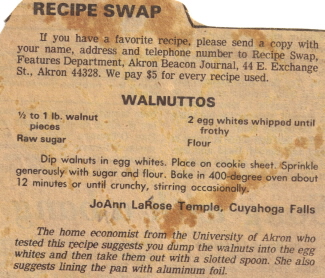
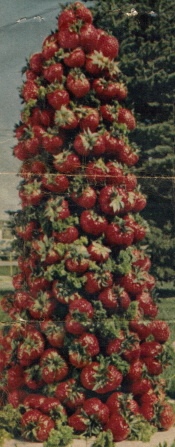 This is a clipping from a magazine found in an old collection of recipes. The article was cut into two pieces (one strip for the directions, the other strip for the picture of the strawberry centerpiece) and then stapled together onto an index card. The instructions for how to make this centerpiece are below.
This is a clipping from a magazine found in an old collection of recipes. The article was cut into two pieces (one strip for the directions, the other strip for the picture of the strawberry centerpiece) and then stapled together onto an index card. The instructions for how to make this centerpiece are below.
Strawberry Table Centerpiece
For a base I use a marble cheese tray, that revolves like a lazy susan, so when one side of the tree gets picked clean, you give the base a twirl and pick from the other side.
Of course, you can use any type tray or platter, just be sure to secure the styrofoam cone to the base with a little florist clay, so the tree won’t come toppling over on your table.
Besides the cone, clay and base you will need: fresh greens, box of round toothpicks, greening pins (available at florists), and, of course fresh strawberries.
The 18-inch cone makes a very large tree that I use for big parties, like for 60 guests when my table has been extended. For a smaller centerpiece, a 12-inch cone works very well and the berries needed would be enough for about 30 guests.
 Depending on the size of the berries, the 18-inch cone takes about six quarts and the 12-inch about three quarts. The berries should be tasty-ripe, yet firm enough so they won’t fall off their toothpick stems.
Depending on the size of the berries, the 18-inch cone takes about six quarts and the 12-inch about three quarts. The berries should be tasty-ripe, yet firm enough so they won’t fall off their toothpick stems.
To assemble the tree, secure with florist clay to base you are using.
Cover the tree with washed and dried greens or leaves. You can use fresh mint, curly endive or parsley or sprigs of holly or camelia or gardenia leaves.
Take sprigs of parsley or mint (or bit of holly) and pin stem part to cone with a greening pin, pressing pin all the way into cone, until cone is fully covered. Save a few greens and some of the largest strawberries to use as garnish around bottom of tree.
Then, take round toothpicks and insert in rows all over the tree.
When you have most of the toothpicks in place, start adding the berries. Gently, but firmly push a fresh berry, cap side out, on each toothpick. Start with large berries on bottom, working to top with smaller berries.
You might have to add a few more toothpicks and berries to fill in, but leave some of the greens showing.
Decorate the base with remaining greens and berries.
The tree should be assembled pretty close to the party time so everything is fresh, but it only takes about 30 minutes to do it, if you have everything ready.
One more thing: This strawberry tree is so beautiful and almost unreal, that people are often hesitant to touch it. So you must keep urging your party guests to “please, pick the berries.”
 Here are pages 50 and 51 from the vintage booklet The Enterprising Housekeeper from the sixth edition (1906).
Here are pages 50 and 51 from the vintage booklet The Enterprising Housekeeper from the sixth edition (1906).
Sandwiches
Sandwiches may be made of white, whole wheat, Graham or brown bread with any kind of meat, fish, salad, eggs, some vegetables, jams or chopped nuts, and spread with butter or mayonnaise dressing. The meat used in sandwiches should be chopped fine, not cut in slices, first for convenience in eating and serving, and secondly, because in this form only is it possible to properly season the sandwich. Fish should be flaked very fine with a fork, and mixed to a paste with the seasonings.
The bread should not be too fresh to cut well, nor will actually stale bread make good sandwiches. It is best when about a day old, should be of fine grain, and be trimmed to good shape before the sandwiches are cut.
The crusts should not be left on, but removed, dried and put through the chopper for crumbs. The butter must be absolutely fresh and good, for in softening, that the bread may be properly spread, any foreign flavor or odor will be brought out. For meat, fish, salad, and egg sandwiches the bread should be cut in squares, oblongs, or triangles; for jam and nut sandwiches it is usually cut round.
Meat Sandwiches
It is usually better to spread the bread with butter before cutting off each slice. This is not necessary when mayonnaise dressing is used. Chop the meat fine, season to taste with salt, pepper, chopped parsley, mustard if desired, onion or celery extract, or any of the various seasonings. Moisten, if necessary, with stock or cream, or mix with a small quantity of mayonnaise dressing. Spread the sandwiches, put together and serve.
The white meat of chicken or turkey, or veal, after being chopped, may be pounded to a paste and mixed with equal quantities of the yolks of hard-boiled eggs, mixed smooth with cream or melted butter. Season to taste.
Egg Sandwiches
Chop the whites of the hard-boiled eggs very fine. Mix the yolks smooth with well-seasoned mayonnaise dressing, add the whites, and spread on the bread.
Deviled Ham Sandwiches
1 cupful of cold boiled ham
Yolks of two hard-boiled eggs
1 teaspoonful of lemon juice
1/4 teaspoonful of mustard
3 teaspoonfuls of melted butter.
Chop the ham fine. Rub the yolks of the eggs smooth with the butter, mix with the ham, mustard and lemon juice, and season to taste. Spread on thin slices of bread. Fold together or roll.
Fish Sandwiches
Fresh fish should be flaked fine, seasoned with salt and pepper, chopped pickle, lemon juice, celery or onion extract, and mixed with mayonnaise dressing, or moistened with a sauce.
Anchovies, sardines or salt fish are better pounded to a paste and moistened with lemon juice.
Vegetable Sandwiches
These are very refreshing with cold meats. Tomatoes, cucumbers, lettuce and water cresses are most commonly used.
Tomatoes or cucumbers should be chopped and mixed with a mayonnaise. Spread the bread with butter, cut delicate slices, and spread with the vegetable. Put together and serve.
Lettuce and water cress should be shredded. Spread the bread with mayonnaise, and mix the lettuce or water cress with a French dressing.
Vegetable sandwiches should be served as soon as possible after making.
Cheese Sandwiches
Grate the cheese fine. Rub it to a paste with melted butter, season with salt and pepper, and spread on the sandwiches.
Sweet Sandwiches
These may be made with marmalades, jam or jellies, anything which will spread without running. Lemon juice or extract flavorings may be used if desired.
Nut Sandwiches
Reduce the nuts to a paste with the Enterprise Food Chopper, using Nut Butter Cutter. Season to taste with salt. Spread on thin slices of bread.
 Here are pages 47, 48 and 49 from the vintage booklet The Enterprising Housekeeper from the sixth edition (1906).
Here are pages 47, 48 and 49 from the vintage booklet The Enterprising Housekeeper from the sixth edition (1906).
Salads
There is, perhaps, no dish which adds more to the luncheon or tea than a nicely prepared salad. In many households a salad is considered an expensive dish–something too good for family use, to be reserved for “company.” This is a mistake, for here, as elsewhere, the “left-overs” may be made to take their place and form appetizing dishes. Cauliflower, celery, peas, beans, spinach, cabbage, potatoes, beets, asparagus, tomatoes, the various greens, such as lettuce, corn, salad, chicory, dandelions, cresses, all these and more may be used separately or in combination for salads.
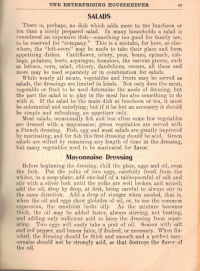 While nearly all meats, vegetables and fruits may be served as salads, the dressings are limited in kinds. Not only does the meat, vegetable or fruit to be used determine the mode of dressing, but the part the salad is to play in the meal has also something to do with it. If the salad be the main dish at luncheon or tea, it must be substantial and satisfying; but if it be but an accessory it should be simple and refreshing, an appetizer only.
While nearly all meats, vegetables and fruits may be served as salads, the dressings are limited in kinds. Not only does the meat, vegetable or fruit to be used determine the mode of dressing, but the part the salad is to play in the meal has also something to do with it. If the salad be the main dish at luncheon or tea, it must be substantial and satisfying; but if it be but an accessory it should be simple and refreshing, an appetizer only.
Meat salads, occasionally fish and less often some few vegetables are dressed with a mayonnaise; green vegetables are served with a french dressing. Fish, egg and meat salads are greatly improved by marinating, and for fish this first dressing should be acid. Green salads are wilted by remaining any length of time in the dressing, but many vegetables need to be marinated for flavor.
Mayonnaise Dressing
Before beginning the dressing, chill the plate, eggs and oil, even the fork. Put the yolks of two eggs, carefully freed from the whites, in a soup-plate; add one-half of a tablespoonful of salt and stir with a silver fork until the yolks are well broken and mixed; add the oil, drop by drop, at first, being careful to always stir in the same direction. Add a drop of vinegar when needed, that is, when the oil and eggs show globules of oil, or, to use the common expression, the emulsion looks oily. As the mixture becomes thick, the oil may be added faster, always stirring, not beating, and adding only sufficient acid to keep the dressing from separating. Two eggs will easily take a pint of oil. Season with salt and red pepper, and lemon juice, if desired, or necessary. When finished, the dressing should be thick and smooth and a perfect mayonnaise should not be strongly acid, as that destroys the flavor of the oil.
French Dressing
Use two-thirds oil to one-third vinegar. For every tablespoonful of vinegar and three of oil take one-half of a tablespoonful of salt and one-fourth of a teaspoonful of black or white pepper. Mix the salt and pepper with the oil and add the vinegar slowly, stirring all the while, until it becomes white and a little thickened. The dressing must be used or served at once or it will separate.
To marinate is to cover with French dressing and allow to stand two or three hours. When ready to serve, the dressing not absorbed should be drained from the meat or vegetable marinated and the salad mixed with the dressing to be used.
Boiled Dressing
2 eggs
1 teaspoonful of salt
1/4 cupful of butter
1 cupful of vinegar
1/4 teaspoonful of pepper
1/2 teaspoonful of sugar
Beat the eggs light without separating; add the vinegar, salt, pepper, sugar and butter melted. Mix well and put over hot water. Stir constantly until the dressing is thickened; cool and serve. If too thick, thin with cream or olive oil, as desired.
Russian Salads
A Russian salad is but a mixture of cold, chopped meats, and may be varied at will to suit the taste, or the exigencies of the situation. Beef, ham, tongue, chicken, lamb, mutton and veal may all be mixed after being finely chopped, but it rarely happens in the home that all these meats are on hand. A mixture of chicken, ham and tongue, with mushrooms and anchovies, may be served on lettuce with a French dressing or sauce Tartare. Roast beef with anchovies make a very good salad, and veal, turkey or chicken with tongue another. Small pieces of cold game may be used and are delicious with a sauce Tartare.
Macedoine Salads
These are mixtures of vegetables and, as with the Russian salad, the mixture depends upon what you have on hand. Carrots, turnips, string beans and peas; asparagus tips with string beans; cauliflower and cresses; potatoes and beets; every little thing counts if used with care. A vegetable salad needs to be dressed carefully that it may look well, and the vegetables should not be broken into too small pieces.
Tomatoes may be stuffed with finely-chopped meat mixed with a mayonnaise, or chicken and celery chopped and dressed together.
Pickled lambs tongues may be chopped and mixed with one-half of a cup of spinach or greens, and dressed with French dressing.
Pieces of cold fish, even smoked and salt, may be utilized.
Eggs may be stuffed with seasoned, chopped meat, and when served as a salad make a hearty and appetizing summer luncheon dish.
Water cress and cabbage shredded together and dressed with a French dressing make an especially palatable salad. A mixture of one-third dandelion with two-thirds lettuce make another, and the celebrated Waldorf salad is but apple and celery chopped together and served with a French dressing delicately flavored with onion.
Chicken Salad
Chop cold, cooked chicken meat into even-sized pieces, not too small. Select the tender stalks of celery, as the outer tough pieces will spoil the salad. Wash, scrape and chop into small pieces. For every two cupfuls of chicken meat take one cupful of celery. Marinate the chicken and keep in a cool place until ready to serve. Mix with the celery. For every quart of salad take one cupful of thick mayonnaise dressing, mix gently with the salad, leaving sufficient to use as a garnish with lettuce leaves or celery tops.
Lobster Salad
Cut the boiled lobster meat into as even pieces as possible. Marinate and put in a cool place until wanted. When ready to serve, mix with shredded lettuce leaves and mayonnaise dressing in the proportion of one-half cupful of dressing to every pint of salad. Serve on curly lettuce leaves, garnished with the dressing and the powdered coral of the lobster if desired. Fish salads of any description should be served at once after mixing.
Cold Slaw
Select a firm cabbage and shred very fine. Mix with a boiled dressing while the latter is hot and put away to cool. Serve when cold. Or the cabbage may be shredded and mixed with French dressing.

